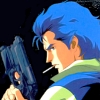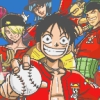-- Above: Kamurocho in Yakuza 3. Below: Kabukicho in Tokyo.
Yakuza (or "Ruy ga gotoku", "Like a Dragon" in Japanese) is a somewhat unique series of videogames, in that it exists in a genuinely Japanese context, and specifically in authentic Japanese culture. Most Japanese games would perhaps have Japanese idiosyncrasies of different kinds, but few games have narratives and stories that are genuinely Japanese.
Because of this, the question of translating the game - or whether to translate it at all - is perhaps an interesting one. The first game received the full Hollywood-treatment, with known voice-actors - mirroring the way the Japanese version has characters and voice-actors that are famous from for example Yakuza movies (we haven't even heard of). But the fact of the matter is that successful translated voice-acting is difficult to accomplish, specially when tone of voice and perhaps untranslatable facial expressions is such an important part of the performance. In the way that no matter how much you perhaps would want an English voice-track, the game simply does not become better with it, as they increasingly make use of film-direction to drive the narratives.
I'm assuming that this (along with very low sales, I suppose) caused SEGA to drop the English voice in the second game. As well as in the third game launched on the ps3 in the EU and North American regions recently. Translating the various honorifics and indirect references is still without a doubt a challenge - but since it is not necessary to make the text match roughly with the lip-syncing, the translation can be a bit more circumspect. Which matches better with the acting, than a shorter sentence would. And after playing through the game, I feel they struck a very good balance between rewriting the script, and between keeping the buildup of the narratives intact. The translation team for Yakuza 3 is definitively top class.
Yakuza's story is also well written and performed. It is perhaps no wonder - the story is adapted from a script written by Hase Seishu, a Japanese novelist who has written a number of Yakuza novels. Some of those books were made into reasonably successful Yakuza movies (that even I had heard of). And characters in the Yakuza universe mirror the appearance of the famous Japanese actors playing them. The mysterious assassin is for example an actor from other Yakuza movies. Though I don't know which film it is, specifically, the face-off scene in the strip-club has the word "homage" written across the screen in bold, flashing letters. Strangely, though, I get the feeling that the scenes in these games are actually way more polished and the acting less artificial than in most Japanese yakuza-movies.
Still, truth be told, the game itself is in many ways fairly dull. You watch a real-time cutscene. The cutscene invariably ends in a fist-fight. The fist fight is interrupted by a set of extremely aggressive quick-time events. And then the game continues in an overwrought dramatic fashion, culminating in a fantastic conspiracy that functions as little else but an excuse for yet another fist-fight, along with a teary-eyed tale of values and honor. And yet, there is something genuinely alluring about it all.

The game tells the story of Kazuma Kiryu, who has put his earlier life as the chairman of the Tojo clan behind him - and is now running an orphanage, raising children the way his foster-father raised him. And, well, that is how you will spend the first 15 minutes of the game - walking around the orphanage on a beach in Okinawa, listening to the intrigues in the "family" Kazuma now runs. Partly in scrolling text, partly in expressively animated cutscenes, like the rest of the game. Of course, eventually, Kazuma's past will catch up with him, and lead him back to Kamurocho in Tokyo once again, to settle matters with his other "family"-members there. One headbutt at a time, set to appropriate fuzz-pop guitar.
The game from that point consists of two main elements. The exploration of the city of Kamurocho. And upgrading your fighting skills and beating the crap out of punks. Both is fun in their own unique ways. The city is modeled after a real (and apparently very famous) area in the Shinjuku district in Tokyo. And you can go around exploring shops and various entertainment facilities there - from bowling and karaoke, to strip-clubs and bars. Some of this is part of the story, but most of it is purely optional. So is meeting famous (and neatly animated) Japanese models (..modeled after actual popular Japanese models) who mysteriously wants to accompany you around town, while admiring your virility in action as you buy them a soda-pop in a convenience store, or sing karaoke.
Aside from that there is the fighting. Which happens on every street-corner (and hopefully is not as authentic as the rest of the city). The fights basically consist of you hitting a combination attack or throw, while dodging or guarding the enemy attacks. Then using a "Heat" action to finish the poor guys off in slow motion. These fights are as easy or difficult as you would like, in all honesty, and can be an immense amount of fun. Unfortunately, the lock-on mechanism is somewhat weak, and you could be unlucky enough to be caught in an endless knock-down cycle, in a way that evidently wasn't intended in the game. And this does sometimes make certain fights extremely frustrating.
On the other hand, you can always retry the fight, and take a different approach to bashing their heads in the next time. Some fights actually require completely different approaches and strategies, which helps keep things fresh.
So there you have it: brutal street-fighting, beautiful Japanese models, and devious yakuza intrigue.
The only thing that is missing, at least from the western release of the game, is the massage parlor and the hostess-bar segments. And although I can see the logic behind this - it would not be easy to translate this content in the same way as the rest of the game, without adding content that was not present already. But that it is not there is also somewhat disappointing.
Of course, I - like the translators no doubt - struggle with actually finding any valid artistic reason to include it, other than for the sake of completion. Nevertheless, it would be interesting if they used the two mentions of the host/hostess clubs that exist in Yakuza 3, and spun an explanation out of this to provide some context. The customs and mannerisms you are told to direct for your hostesses after this would easily provide themselves as an interesting distraction complementing the rest of the game, I believe, even if you would very likely fail at creating the perfect hostess.
The lack of hostess-bars in the western version serves to illustrate a different point about the game, though. And that is how universal everything else is, even though it's clothed in Japanese mannerisms and backdrops. Kazuma also makes priceless comments about the exaggerated use of honorifics, or the selfish use of customs, which serves to sharpen the running theme about honor, values and rules - and when they lose their meaning. Whether it is in politics, in the underworld, or in the orphanage.
This is also how the writers dealt with having yakuza in the game. They glorify the yakuza to a certain degree, but only on certain conditions. It is a deep tale Sega Japan has spun for us here, and one that will tug at your heart-strings in several ways. I did not cry while I played this game. But I laughed heartily several times, and choked up more than once.
Yakuza 3 is not Grand Theft Auto set in Japan, but more like a semi-interactive yakuza-movie - where you can spend any amount of time between the story and action sequences by walking through an authentic Japanese city, doing authentic and hilariously pointless things.
In addition you can fight as much as your heart desires. Of course while remembering, always - whenever you finish a punk off by slamming a lit gas-grill into their forehead in slow motion - that you are doing this for honor, traditional values, and for the sake of the children at the orphanage.
Played through the story-mode, and ended up at 21 hours playtime, with a 10% completion rate. Immediately started a new "premium" game, and further upgraded my fighting skills, which was quite satisfying. The game has a 15 minute install. It includes a short version of the plot in the two previous yakuza games. And it's the only game I've played with triple overlapping "meanwhile" scenes. "Shikashi!" Here's hoping for Yakuza 4 to be localised soon.
 |  |  |  |  |
Community review by fleinn (April 05, 2010)
A bio for this contributor is currently unavailable, but check back soon to see if that changes. If you are the author of this review, you can update your bio from the Settings page. |
|
More Reviews by fleinn [+]
|
|
If you enjoyed this Yakuza 3 review, you're encouraged to discuss it with the author and with other members of the site's community. If you don't already have an HonestGamers account, you can sign up for one in a snap. Thank you for reading!
User Help | Contact | Ethics | Sponsor Guide | Links












